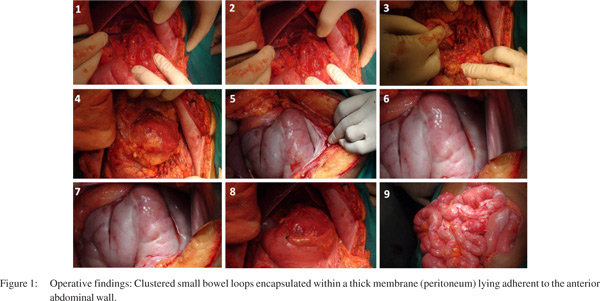MD. Aejaz Habeeb1, Sandeep K Vishwakarma1, Mohd. Abdul Wajid1, Avinash Bardia1, Aleem A Khan1, N. Bheerappa2
Centre for Liver Research and Diagnostics1,
Deccan College of Medical Sciences,
Kanchanbagh, and Nizams Institute of Medical Sciences (NIMS)2,
Hyderabad-500082, Andhra Pradesh, India
Corresponding Author:
Dr. Md. Aejaz Habeeb
Email: aleem_a_khan@rediffmail.com
DOI:
http://dx.doi.org/10.7869/tg.269
48uep6bbphidvals|729 48uep6bbph|2000F98CTab_Articles|Fulltext Abdominal cocoon or Sclerosing Encapsulating Peritonitis is due to thick fibrotic peritoneum encasing the small bowel in a small volume. The exact etiology of this type of intestinal obstruction is often unclear. Abdominal cocoon is rarely seen in male patients and we report one such case.
Case report
A 55 year old male lorry driver presented with abdominal pain and distension along with vomiting since 6 months. In addition, the patient had history of progressive anorexia and weight loss (up to 10 kg). Abdominal X-ray report revealed the presence of few dilated bowel loops (air filled bowel loops) and had no free air. A computed tomography (CT) was done and reported the presence of intra abdominal cocoon encasing the small bowel loops. Laporotomy and adhesiolysis showed multiple small bowel interloop adhesions, all bowels were covered with peritoneal layer and liver was found adherent to anterior abdominal wall. (Figure 1).

Discussion
Abdominal Cocoon Syndrome (ACS) or Sclerosing Encapsulating Peritonitis is a rare cause of intestinal obstruction characterized by fibrotic encapsulation of the bowel forming a sac or cocoon along with some intestinal adhesions. The encasing membrane is an opaque fibrous structure which is not covered by mesothelium. It was first described by Owtschinnikow (1907) as peritonitis chronic fibrosa encapsulate and termed as abdominal cocoon by Foo et al. (1978).[1]The exact etiology of ACS is obscure, but can be classified as primary (idiopathic) type and acquired (secondary) type. Acquired type is more common than primary type. Primary or Idiopathic form was found in adolescent girls from tropical or subtropical countries. Early menstruation and primary peritonitis caused by retrograde menstruation, superimposed with viral infection may be the most important etiological factors in this type.2 Rarely idiopathic cocoon has been described in males and an infective etiology has been suggested to account for this. Whereas prolonged â-blocker therapy (Practolol), local irritation of the peritoneum by trauma or surgical operation, intraperitoneal medical therapy (sterilizing chemicals like povidone, chemotherapeutic agents), peritoneal dialysis, peritoneal venous shunting, V-P shunts and infectious peritonitis, sarcoidosis, SLE, propranolol therapy for constrictive pericarditis, fibroid uterus, ovarian tumour and endometriosis are the major causes of secondary form which may predispose patients to peritoneal irritation subsequently inflammation that finally leads to peritoneal fibrogenesis.[2]
Kaushik et al. reported 6 cases of abdominal cocoon due to tuberculosis where the diagnosis was made during surgery.[3] These cases presented with acute internal obstruction and caseating epitheloid cell granulomas was demonstrated in the membrane, although AFB bacilli could not be demonstrated.
References
- Foo KT, Ng KC, Rauff A, Foong WC, Sinniah R. Unusual small intestinal obstruction in girls: The abdominal cocoon. Br J Surg. 1978;65:427–30.
- Sieck JO, Cowgill R, Larkworthy W. Peritoneal encapsulation and abdominal cocoon: Case reports and a review of the literature. Gastroenterol. 1983; 84:1597–601.
- Kaushik R, Punia RPS, Mohan H, Attri AK. Tuberculosis abdominal cocoon- a report of 6 cases and review of the literature. W J Emerg Surg. 2006;1:18.
|